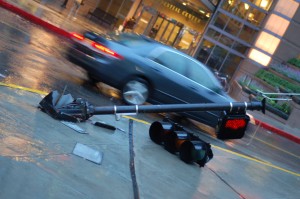Nothing requires so keen a notice, so focused a concentration, so large and intimidating a vehicle, as does driving in Boston.
When we first moved to Boston from western Pennsylvania, we were both intrigued and horrified to see public roadways under construction, with potholes dug the size of the Great Lakes and manhole covers raised as tall as Flathead Mesa. Well, since I was just a boy at the time, maybe the potholes and manhole covers seemed a little bigger than they actually were. But the roads were conspicuously marked with signs–and this is actually true–“Danger! Proceed at your own risk!” Well, perhaps the signs didn’t have exclamation points, but they might as well have, because they made me feel as though we were about to drive off the edge of the continent and might fall into the ocean. (I had heard that Boston was close to the ocean.)
(As I’m sure someone is going to mention, these signs are only posted in some areas on New England, such as Connecticut. In the Boston area, the roads and construction and possibility for automobile damage is the same, but the explicit warning is missing.)
I recall my father oh so cautiously proceeding down these roadways, carefully weaving between potholes and manhole covers, the tires grinding against the unfinished roadway as we putted down this dangerous avenue. Meanwhile, the native Bostononians flew by us at highway speed, cursing us as they went, clearly unafraid of falling into the ocean. But then again, having grown up in the area, they probably intuitively knew where the edge was.
That was almost 25 years ago, and since then I’ve gotten my own genuine Massachusetts driver’s license, learned how to navigate the roads here, and even how to assert myself behind the wheel of a car. And in the process, in all my years of driving in the Boston area, I’ve only gotten into five accidents.
The first happened shortly after I got my first car, while I was pulling into a parking space. And it wasn’t my fault, because the other guy should have known better than to park his car right next to where a new Boston driver was going to be pulling in.
The second also wasn’t my fault. My car ran into some lady’s car from behind, because she failed to pull out into the rotary fast enough.
In the third, I totaled my new Chevy Geo Prism. Some idiot changed lanes on 128 without signaling properly. I swerved to compensate. And still getting used to the steering mechanism on my new car, I overcompensated. I was wearing no seatbelt at the time, and it was only by the grace of God that I got a second chance, in order to share with you this injunction: Gonna make a turn? Tell the world about it!
My fourth accident also wasn’t my fault, because they shouldn’t have put that pole there.
My fifth and last accident truly wasn’t my fault. It couldn’t have been, because I wasn’t even in the car at the time. I had parked my car on a side street, near the corner. Clearly, some idiot then swung the corner wide and barreled into the side of my car. At least he had the courtesy not to leave a note, because for all he knew, I probably would have torn his head off. And he might have had to pay for the damage, too.
But the basic problem with Boston drivers is that they have no social skills. This is no accident—so to speak. Boston drivers acquire their rudeness, ignorance, and self-centered egotism only after a lifetime of careful practice.
Take the four-way stop as an example. There’s nothing magical or mysterious about the four-way stop. Four roads meet at a common point. We obviously can’t all drive through the intersection at once, or else we’d get into a massive 10-car pileup, which indeed would be fun, but 10-car pileups are only for the Pike. So at a four-way stop, we have a simple rule: the first person to get to the intersection goes first. In other words, we take turns. Now, we teach our children from the time they can say, “Mine! Mine!” how to take turns. This basic social skill does not require an advanced degree in particle physics. The four-way stop is a system any four-year old could master. There’s a big red sign, in the shape of an octagon, emblazoned with the letters S-T-O-P. You drive your car up to the sign, stop for a few seconds, wait for your turn, and then go through.
But alas, this is too complicated for the average Boston driver. So even when he notices the big red sign, he rarely follows its instruction. You see, unlike you, he knows it’s just a suggestion: “Stop, if you feel like it. But not if you can get through first!” This is why when a Boston driver approaches a four-way stop, he first drives past the stop-line and into the intersection—even before slowing down. Then if there are other cars also vying for the right of way, he continually inches forward, daring them to run into him. Only when one of the other vehicles seems to have accepted his challenge does he proceed through the intersection.
(to be continued next Friday)

As Homer Simpson is wont to say, “It’s funny because it’s true!”
[…] for all involved if I kept off the road. Plus, I was crap-your-pants terrified of taking on the infamous Boston traffic (and I once jumped off a mountain in New Zealand with nothing other than a flimsy tarp and a Kiwi […]